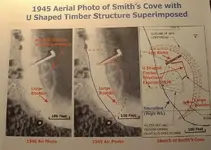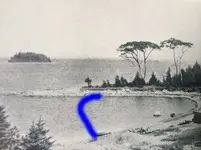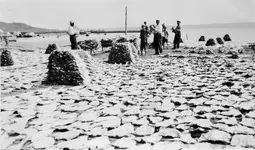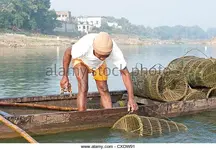gazzahk
Bronze Member
- Joined
- Nov 14, 2015
- Messages
- 1,720
- Reaction score
- 2,584
- Golden Thread
- 0
- Primary Interest:
- All Treasure Hunting
- #61
Thread Owner
Yep... Joy does offer little in the way of evidence. Shape of hole, charcoal in pit, need for stores (edit: forgot - Box that she claims looks like tar funnel, documentary evidence that shows naval stores were being produced in NS, carvings on rocks, trees in area that she claims represent naval store related markings, evidence of British there - old coins etc) and that is about it...1. any tar pit would have been shown on british naval maps of the day, since they were a necessary function.. Sides there would be some evidence of the tar left. none have surfaced so farr
I do not know about this. It may of been a pretty temporary operation and I guess that maps were not accurate then.2. Fish processing also would be on the maps of that period. Other lesser operations were.
Her evidence of the sea level change is pretty limited. I agree it seems like more evidence should exist if the sea level changed that much in 350 years.3. Sea level has not risen that much.
There is no evidence that the drains were ever connected to the pit. People have looked for it many times and no flood tunnel has been found or blocked.4. The drainage tunnels were delibertly constructed to lead into the pit.not out
That is pretty definite "that it has no place here' how are you so sure?5. The soil liquification is feasable but not proven, there would be other evidence, nor does it have a place here.
I did not think there was anyone that had been watching the show that still believed in the tunnels and treasure... I Think you are wrong but would be happy if they prove you right. I do not think man made flood tunnels exist. No evidence of them has been found6. I still think that the drainage tunnels were a form of a trap to protect whatever was buried there, although access to the deposiory is above the cove level, since they obviously intended to recover it some day, This was probably accessed by a lateral tunel in the fir
st part of the excavation and now lost.
As discussed before.. There would be no need to cover the whole beach if this was the case only the drains would need covering.7 The coco nut fibres and the eel grass were put in the drains for a specific reason, to keep the tnnels as free of debris as long as possiblt. And the drainage is from the cove to the pit..
If there was treasure there down over 100ft depth I do think that it is feasible the treasure hiders would have an alternative method to recover it. This though is an additional reason why I do not believe that treasure was buried at over 100 feet.8. I can see nothing new, the pit was dug as a distraction while the main room is off to one side above high water level, readily recoverable if the water trap had ben sprung and the pit was full of water
Out of all the treasure theories put forward British military engenerers soldiers seemed the most plausible. However if treasure was buried by a military operation it would of been retrived and would not still be there.9. The problem still remains "What was buried there" ? I don't accept the Havana operation, since there would be too many naval personel involved, the king had very interesting ways to extract information..
.
.
Thanks Real of Tayopa for sharing your thoughts on Joys theory...
Last edited:






 ,
,
 ). Never really paid much attention to how they softened it but do seem to remember that water and beating was involved…
). Never really paid much attention to how they softened it but do seem to remember that water and beating was involved…
